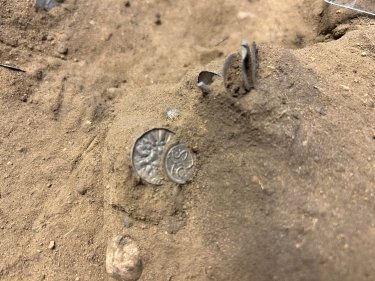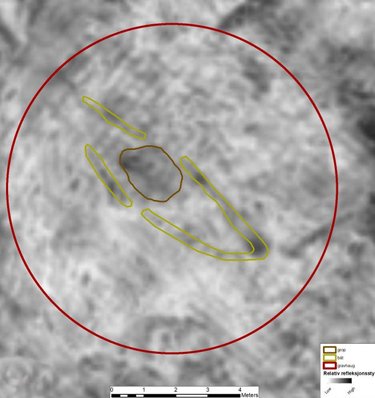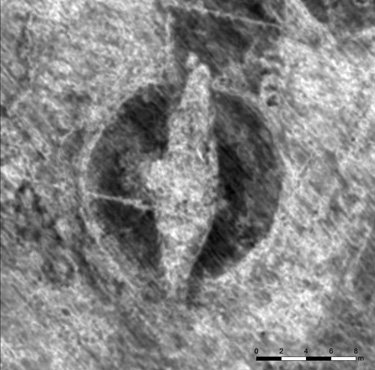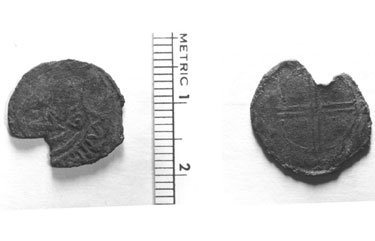Category Archive 'Vikings'
24 Apr 2023


The History Blog reports the latest metal detecting finds.
Two hoards of Viking hacksilver and coins dating to the late 10th century have been unearthed under a cornfield near Bramslev in northern Jutland. The two treasures were discovered less than 165 feet apart and are very similar in content. They were originally even closer, but later agricultural activity disturbed the deposits, intermingling the coins and other silver objects.
The first pieces were discovered last fall by Jane Foged-Mønster, a member of a local metal detecting association, Nordjysk Detektorforening, during a rally on a farmed field. She spotted a piece of silver which turned out to be a clipped Arabic dirham coin, then another fragment, this time a decorated silver ball from a ring buckle. The group, which works closely with museum archaeologists, recognized this was a treasure find and alerted experts from the North Jutland Museum.
Archaeologists followed up quickly with a rescue excavation of the site. Because it was actively in use for agriculture, anything else that might have been part of the hoard remaining in the plow layer was at imminent risk of being scattered or even destroyed. Jane Foged-Mønster and two of her co-discoverers from the metal detecting group aided in the excavation.
The archaeological team and volunteers spent a week digging at the site. They unearthed 300 finds, from small clippings of silver to jewelry and coins. The decorated ball terminal on a silver rod that Jane Foged-Mønster found has a pair. They both weigh about 70 grams (2.5 oz) and originally were part of the same piece of jewelry, likely a very large ring brooch. This type of jewel was worn by high-status men of Viking Ireland. Something this large and heavy and ornately decorated would have belonged to someone at the highest echelons of society like a bishop or even a king. It was likely looted by Danes in a raid and cut up for its silver weight.
Among the 300 finds are 50 coins, most of them Danish, but also German and Arabic. Some of the Danish coins are extremely rare cross coins struck in the reign of Harald “Bluetooth” Blåtand in the 970s and 980s. The crosses on the coins are believed to be connected to his King Harald’s conversion to Christianity and his aim of Christianizing the Danes. The ring fort of Fyrkat, built by King Harald Bluetooth around the same time the coins were struck, is just five miles away from the hoard site.
RTWT
10 Apr 2022

Ancient Pages:
A new Viking Age ship has been discovered by archaeologists in Norway during a ground-penetrating radar (GPR) survey. This exciting find reveals a huge Viking boat buried beneath the ground in Øye, in Kvinesdal. …
Archaeologists from the Norwegian Institute for Cultural Heritage Research (NIKU) said the ancient boat was spotted while researchers conducted geophysical surveys in the area as part of the road-building project E39 led by Nye Veier.
The surveys are a part of the research project “Arkeologi på Ney Veier” (Archaeology on new roads). Based on preliminary reports, archaeologists estimate the Viking boat to be between 8 to 9 meters long.
Niku researchers inform that in addition to the boat burial there are traces of several other burial mounds.
At present, it is still unknown how much of the Viking boat remains. Excavations must be carried out and hopefully, the new road project will not interfere with archaeologists’ work.
RTWT
14 Jan 2022


Victor E. Viking, the mascot of Western Washington University.
The College Fix reports:
Western Washington University may scrap its Viking mascot and is currently conducting an investigation to help make a final decision on the issue.
The effort was spawned in part from requests asking the public university to remove the names of four buildings on campus due to racism concerns: Huxley College of the Environment, Mathes Hall, Haggard Hall, and the Viking Union.
In December, trustees announced that T.H. Huxley’s name would be removed, citing the scientist’s “white supremacist values that dehumanize and harm many members of the Western community.” The Haggard and Mathes names were spared.
But the verdict is out on the Vikings. A “strong majority” of the university’s Legacy Review Taskforce recommended to trustees to remove “Viking” from the Viking Union.
“The Task Force was concerned about the harm caused by asking all members of the Western community to identify with a figure that is potentially exclusive on the basis of both ethnicity and gender,” the taskforce stated in its report.
“Furthermore, the Task Force found names idolizing conquest as out of line with the university’s contemporary values around honoring local Indigenous communities. Task Force members who did not recommend renaming in this report proposed the building name be evaluated alongside the mascot by a separate committee.”
Trustees directed the university “to conduct a more thorough assessment of the Viking name in the broader context of the University mascot,” the December news release states.
The media and communications team at Western Washington University did not respond to requests from The College Fix seeking comment. …
This is not the first time that a mascot change at WWU has been raised. In 2015, an effort to get it scrapped claimed the Viking mascot is “hyper-masculine” and “aggressive.”
However, the area is steeped in Scandinavian roots. In 1910, 30 percent of the foreign-born population had Scandinavian blood. The National Nordic Museum is also located in Seattle, Washington.
Despite the heritage, the Viking as a mascot, in general, may still be on its way out.
During the current Washington Football Team name scandal, many people looked for other teams that may change their alleged problematic names. The Minnesota Vikings is a major team considered.
A change.org petition argued the NFL mascot is “highly distasteful.” It argued the Vikings thought “they were entitled to anything they want and not living in harmony with groups of people with differing ideologies.”
RTWT
———————-
Robert Spencer, at PJM, notes that the rationale for cancellation is completely flexible. Indian mascots are allegedly demeaning, but white male mascots are complimentary and that too is bad.
[I]t’s hard not to notice that the entire mascot brouhaha, from beginning to end, is not only stupid; it’s incoherent. The Redskins and Indians were forbidden because the use of Native Americans as mascots was supposedly degrading and dehumanizing. The names had to go because they were demeaning and insulting. All over the country, teams at all levels dropped their Indian-related names in order to show their respect and regard for American Indians.
At the same time, however, teams all over the country have dropped their Crusader nickname because they don’t want to seem to be glorifying the Crusaders, which in modern myth (and not remotely in reality) were rapacious, imperialist, unprovoked attacks upon peaceful, wise, indigenous Muslim people. The schools that bore the Crusader name didn’t want to appear to be supporting such actions by white supremacists against innocent people of color, so the Crusaders had to go. And now it’s a similar situation at WWU with the Vikings: Western Washington University doesn’t want to appear to be “idolizing conquest.”
But wait a minute. If the Washington Redskins and Cleveland Indians degraded Native Americans, why do teams named Crusaders or Vikings glorify racism and white supremacy? If what Leftists have been telling us about nicknames and mascots for the last few years were even close to true, woke WWU should proudly retain its Viking name and declare that they’re doing so in order to demean and insult Vikings and white people in general. After all, if team names actually glorified the group that inspired them, then the Redskins and Indians had no reason to change their name, right?
Related: Woke Mob Puts Out Hit on Notre Dame’s Leprechaun
But the Leftists don’t have to worry about consistency. They know that the establishment media will never call them out on their contradictions. No “journalist” today will ever ask why some team names can be seen as glorifying the group in question, while other team names are degrading.
RTWT
15 May 2020


Very cool news from the History blog:
In October 2018, a geophysical survey of a field in Halden, southeastern Norway, revealed the presence of Viking ship burial. The landowner had applied for a soil drainage permit and because the field is adjacent to the monumental Jell Mound, archaeologists from the Norwegian Institute for Cultural Heritage Research (NIKU) inspected the site first. Using a four-wheeler with a georadar mounted to the front of it. The high-resolution ground-penetrating radar picked up the clear outline of a ship 20 meters (65 feet) long.
The ship was found just 50 cm (1.6 feet) under the surface. It was once covered by a burial mound like its neighbor, but centuries of agricultural work ploughed it away. Subsequent investigation of the area found the outlines of at least 11 other burial mounds around the ship, all of them long-since ploughed out as well. The georadar also discovered the remains of five longhouses.
In order to get some idea of the ship’s age, condition and how much of it is left, in September of 2019, NIKU archaeologists dug a test pit was dug to obtain a sample of the wood of the keel. The keel was of a different type to ones from other Viking ship burials known in Norway. It is thinner and smaller than usual. The two-week investigation and analysis of the sample found that the ship does indeed date to the early Viking era. The wood was felled between the late 7th century and the start of the 9th century. Later dendrochronological analysis narrowed down the date to the period between 603 and 724 A.D.
In more distressing news, the analysis of the sample revealed that the wooden remains were under severe attack from fungus. The use of fertilizer on the farmland above the ship encourages the fungal growth and not only is the keel plagued by soft rot, the remains even at the deepest point where preservation conditions are the best possible are under acute distress.
Norway’s government has responded to the archaeological emergency by allocating 15.6m kroner (about $1.5 million) to excavate the Gjellestad Viking Ship and get it out of the ground before it rots to nothingness. While other Viking ship burials have been excavated in recent years, the last Viking ship burial mound to be excavated was the Oseberg ship in 1904-1905. If the Norwegian parliament approves the budget, excavation of the Gjellestad Ship is slated to begin in June.
RTWT
HT: Bird Dog.
03 Nov 2019


British scientists have reconstructed the face of a female Viking warrior who suffered a head wound and was buried with weapons.
Daily Mail:
Scientists have re-created the face of a female Viking warrior who lived more than 1,000 years ago.
The woman is based on a skeleton found in a Viking graveyard in Solør, Norway, and is now preserved in Oslo’s Museum of Cultural History.
While the remains had already been identified as female, the burial site had not been considered that of a warrior ‘simply because the occupant was a woman’, archaelogist Ella Al-Shamahi told The Guardian.
But now British scientists have brought the female warrior to life using cutting-edge facial recognition technology.
Scientists reconstructed the face of the female warrior who lived more than 1,000 years ago by anatomically working from the muscles and layering of the skin
And scientists found the woman was buried with a hoard of deadly weaponry including arrows, a sword, a spear and an axe.
Researchers also discovered a dent in her head, which rested on a shield in her grave, that was consistent with a sword wound.
It is unclear whether the brutal injury was the cause of her death however it is believed to be ‘the first evidence ever found of a Viking woman with a battle injury’, according to Ms Al-Shamahi.
She added: I’m so excited because this is a face that hasn’t been seen in 1,000 years… She’s suddenly become really real.’
RTWT
14 Oct 2019


Peterson Type H, Wheeler Type II Viking Sword 9th Century.
Archaeology.org:
[P]ieces of some 100 Viking swords and spearheads dating to the middle of the tenth century A.D. were found in two caches placed about 260 feet apart along a remote Viking trade route near Estonia’s northwestern coast. Archaeologist Mauri Kiudsoo of Tallinn University said the bits of broken weapons may have been cenotaphs, or items left as a monument to warriors who had died and were buried somewhere else. The surviving sword parts provide enough information, however, to know the weapons included H-shaped double-edged swords. Eight nearly intact type H swords and fragments of 100 more have been found in Estonia alone.
—————————-
ERR News:
The fragments were found in two closely located sites in a coastal area of north Estonia, in the territory of the ancient Estonian county of Ravala, late last autumn.
The finds consisted of dozens of items, mostly fragments of swords and a few spearheads.
Mauri Kiudsoo, archaeologist and keeper of the archaeological research collection of Tallinn University, told BNS the two sites were located just 80 meters apart. The swords date from the middle of the 10th century and are probably cenotaphs, grave markers dedicated to people buried elsewhere.
The reason why the swords were not found intact, Kiudsoo said, is due to the burial customs of the time. It is characteristic of finds in Estonia from the period that weapons were put into the graves broken or rendered unusable.
While the Ravala fragments constitute the biggest find of Viking-era weapons in Estonia, more important according to Kiudsoo, is the fact that the grips of the swords allow us to determine which type of swords they are. They have been identified as H-shaped double-edged swords. This type of sword was the most common type in the Viking era and over 700 have been found in northern Europe.
Kiudsoo said that by 1991, eight more or less intact type H swords and about 20 fragments had been discovered in Estonia but the number has risen to about 100. The overwhelming majority of the Estonian finds have come to light on the country’s north coast, which lies by the most important remote trade route of the Viking era.

Sword Pommel, XI-XIII century from Läänemaa, Estonia.
04 Jun 2019


Big news from the BBC:
A medieval chess piece that was missing for almost 200 years had been unknowingly kept in a drawer by an Edinburgh family.
They had no idea that the object was one of the long-lost Lewis Chessmen – which could now fetch £1m at auction.
The chessmen were found on the Isle of Lewis in 1831 but the whereabouts of five pieces have remained a mystery.
The Edinburgh family’s grandfather, an antiques dealer, had bought the chess piece for £5 in 1964.
He had no idea of the significance of the 8.8cm piece (3.5in), made from walrus ivory, which he passed down to his family.
They have looked after it for 55 years without realising its importance, before taking it to Sotheby’s auction house in London. …
Sotheby’s expert Alexander Kader, who examined the piece for the family, said his “jaw dropped” when he realised what they had in their possession.
“They brought it in for assessment,” he said. “That happens every day. Our doors are open for free valuations.
“We get called down to the counter and have no idea what we are going to see. More often than not, it’s not worth very much.
“I said, ‘Oh my goodness, it’s one of the Lewis Chessmen’.”
Mr Kader, Sotheby’s co-worldwide head of European sculpture and works of art, said the family, who want to remain anonymous, were “quite amazed”.
“It’s a little bit bashed up. It has lost its left eye. But that kind of weather-beaten, weary warrior added to its charm,” he said.
Despite not knowing its significance, the late 12th/early 13th Century chess piece had been “treasured” by the family.
The current owner’s late mother believed it “almost had magical qualities”.
A family spokesman said in a statement: “My grandfather was an antiques dealer based in Edinburgh, and in 1964 he purchased an ivory chessman from another Edinburgh dealer.
“It was catalogued in his purchase ledger that he had bought an ‘Antique Walrus Tusk Warrior Chessman’.
“From this description it can be assumed that he was unaware he had purchased an important historic artefact.
“It was stored away in his home and then when my grandfather died my mother inherited the chess piece.
“My mother was very fond of the Chessman as she admired its intricacy and quirkiness. She believed that it was special and thought perhaps it could even have had some magical significance.
“For many years it resided in a drawer in her home where it had been carefully wrapped in a small bag. From time to time, she would remove the chess piece from the drawer in order to appreciate its uniqueness.”
The Lewis Chessmen set includes seated kings and queens, bishops, knights and standing warders and pawns. Some 82 pieces are now in the British Museum and 11 pieces held by the National Museum of Scotland. As well as the chess pieces, the hoard includes 14 “tablemen” gaming pieces and a buckle.
Since the hoard was uncovered in 1831, one knight and four warders have been missing from the four combined chess sets.
The newly-discovered piece is a warder, a man with helmet, shield and sword and the equivalent of a rook on a modern chess board, which “has immense character and power”.
The discovery of the hoard remains shrouded in mystery, with stories of it being dug up by a cow grazing on sandy banks.
It is thought it was buried shortly after the objects were made, possibly by a merchant to avoid taxes after being shipwrecked, and so remained underground for 500 years.
Mr Kader, who has kept the discovery under wraps for six months while authenticating the find, said: “We can safely say that a million pounds will transform the seller’s life.”
He added: “There are still four out there somewhere. It might take another 150 years for another one to pop up.”
——————-
Sotheby’s write-up.
05 Sep 2018


The extreme nature of the ornamentation on this sword, combined with the unusual (for Scandinavia) motifs coupled with the apparent lack of a fuller (lenticular, ‘grooveless’ sword blades being a common hallmark of swords from Constantinople) may indicate that this sword was manufactured in Byzantium and may have belonged to a Varangian Guardsman or may have been gifted to a Nordic person held in esteem by the Romans.
With double-edged blade of gradual taper; inlaid on both sides in gold and silver with decorative patterns, one side bearing a gradually tapering geometric-architectural design in five stages and the other bearing a gradually tapering palmette design. The hilt comprising down-curved cross guard, sturdy tang and five-lobed pommel riveted to the upward-curving upper guard; the cross-guard, upper guard and pommel all inlaid in silver with decorative knotwork and tracery and in gold with dots.
Overall length: 94 cm (37″); Blade length: 80.6 cm (31.75″)
This rare Viking sword, the hilt of Petersen Type O, has a cross-guard with decorative devices reminiscent of those on one of the three swords that were found in the rich ship burial of about 900 at Hedeby in Denmark when it was subsequently excavated in the 1950s. More of these ‘rabbit ear’ or ‘knotted rope’ characters may be found on three of the ‘Hiltipreht’ group of swords, namely one in the Wallace Collection, London (Inv. No. A456), the Ballinderry sword in the National Museum of Ireland, Dublin (Inv. No.1928.382) and the example from Malhus in the Trondheim Museum, Norway (Petersen, Abb.89).
The credentials of this prestigious weapon are further enhanced by the decoration upon the blade. On one side there is a palmette design of inlaid silver with traces of gold that is very similar to that on a fragmented blade from the River Bann in Ireland and illustrated in Bøe. This should be compared with the inlay on a sword from the Waal near Nijmegen (Oakeshott, Records of the Medieval Sword, p.47). On the other side, the inlaid precious metals may well represent a schematic plan view of a building, as is believed to have been intended upon another silver inlaid sword illustrated and described by Ewart Oakeshott (Records of the Medieval Sword, pp.28-29).
23 Dec 2017


Atlas Obscura:
The story that Guy Mellgren told about the curious silver coin began on the shores of Maine, where he met a stranger named Goddard. In the fall of 1956, Mellgren and Ed Runge, a pair of amateur archaeologists, had come in search of the most basic of coastal dig sites—a shell midden—when they happened onto a more unusual discovery.
Goddard had invited them to explore his shoreline property, and there, on a natural terrace about eight feet above the high tide line, they found stone chips, knives, and fire pits, along with an abundance of other unexpected artifacts. Each summer for many years, Mellgren and Runge returned to excavate the “Goddard Site,†with little help from professional archaeologists. In the second summer, they produced the coin.
For two decades, based on an analysis by a friend in a numismatics club, Mellgren described it as a coin minted in 12th-century England, and no one questioned that identification. The discovery should have been noteworthy—there’s no good explanation for how a medieval English coin could have crossed the Atlantic—but Mellgren never sought wider attention for the find. It was a curiosity to show off to friends and his son’s classmates, until, in 1978, a scrappy regional bulletin published a picture of the coin and an article titled, “Were the English the First to Discover America?â€
That picture found its way to a well-known London dealer, who recognized at once that the coin could not have come from England. Two weeks after Mellgren died, the coin’s reidentification swept into the news. It was a Norse penny, made between 1065 and 1093—evidence for Viking contact with North America centuries before Columbus.
All of sudden, experts from around the world began taking a careful look at the details of Mellgren’s story. Of many objects purported to prove a Viking presence in North America, only the artifacts painstakingly excavated at L’Anse aux Meadows, in Newfoundland, have stood up to investigation. The rest—the Beardmore relics, the Vinland Map, the notorious Kensington Rune Stone—are all considered hoaxes.
Since 1978, no one has questioned that the Mellgren coin is an authentic Norse penny, made in medieval Scandinavia. But 60 years after Mellgren’s find, archaeologists and numismatic experts are still asking how in the world this small, worn coin got to Maine.
RTWT
Hat tip to Glenn Reynolds.
/div>

Feeds
|















